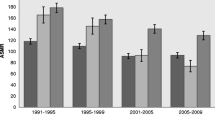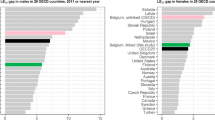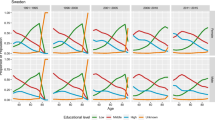Abstract
The aim of this study is to determine trends in life expectancy by educational level in Belgium and to present elements of interpretation for the observed evolution. The analysis is based on census data providing information on educational level linked to register data on mortality for the periods 1991–1994 and 2001–2004. Using exhaustive individual linked data allows to avoid selection bias and numerator–denominator bias. The trends reveal a general increase in life expectancy together with a widening social gap. Summary indices of inequality based on life expectancies show, however, a more complex pattern and point to the importance to include the shifts in population composition by educational level in an overall assessment of the evolution of inequality by educational level.
Résumé
L’objectif de l’étude est de déterminer le sens et l’ampleur de l’évolution des inégalités en espérance de vie en Belgique selon le niveau d’instruction. L’analyse part des données des recensements qui fournissent l’information sur le niveau d’instruction. Ces données ont été liées au registre de la population qui fournit l’information sur la mortalité pour les périodes 1991–1994 et 2001–2004. L’utilisation de données exhaustives et d’un enregistrement de la mortalité lié directement aux données du recensement évite des erreurs de sélection et du biais entre numérateur et dénominateur. On peut constater qu’en général l’espérance de vie progresse pour tous les niveaux d’éducation mais que cela va de pair avec un élargissement des inégalités. L’utilisation d’indices d’inégalité montre néanmoins une réalité plus complexe et la nécessité d’inclure l’évolution de la composition de la population par niveau d’éducation dans une évaluation globale de l’évolution des inégalités.



Similar content being viewed by others
References
Abraído-Lanza, A. F., Dohrenwend, B. P., Ng-Mak, D. S., & Turner, J. B. (1999). The Latino mortality paradox: A test of the “Salmon Bias” and healthy migrant hypotheses. American Journal of Public Health, 89 (10), 1543–1548.
Arber, S. (1997). Comparing inequalities in women’s and men’s health: Britain in the 1990s. Social Science & Medicine, 32, 425–436.
Arber, S., & Lahelma, E. (1993). Inequalities in women’s and men’s ill health: Britain and Finland compared. Social Science and Medicine, 37(8), 1055–1068.
Arriaga, E. (1984). Measuring and explaining the change in life expectancies. Demography, 21(1), 83–96.
Bosma, H. (2006). Socio-economic differences in health: Are control beliefs fundamental mediators? In J. Siegrist & M. Marmot (Eds.), Social inequalities in health, new evidence and policy implications (pp. 153–166). Oxford: Oxford University Press.
Bossuyt, N., Gadeyne, S., Deboosere, P., & Van Oyen, H. (2004). Socio-economic inequalities in health expectancy in Belgium. Public Health, 118, 3–10.
Davey-Smith, G., Hart, C., Hole, D., McKinnon, P., Gillis, C., Watt, G., Blane, D., & Hawthorne, V. (1998). Education and occupational class: which is the more important indicator of mortality risk? Journal of Epidemiology and Community Health, 52(3), 153–160.
Elo, I. T., & Preston, S. H. (1996). Educational differences in mortality: United States, 1979–85. Social Science and Medicine, 42(1), 47–57.
Fox, A. J. (Ed.). (1989). Health inequalities in European Countries. Proceedings of European Science Foundation workshops, London, 1984–1986. Aldershot: Gower Press.
Gadeyne, S. (2006). The ultimate inequality. Socio-economic differences in all-cause and cause-specific mortality in Belgium in the first half of the 1990s. NIDI/CBGS-publications, 39. Dordrecht: Kluwer Academic Publishers.
Gadeyne, S., & Deboosere, P. (2002). Socio-economische ongelijkheid in sterfte op middelbare leeftijd in België. Een analyse van de Nationale Databank Mortaliteit. Brussels: Statistics Belgium.
Galobardes, B., Shaw, M., Lawlor, D. A., Lynch, J. W., & Davey Smith, G. (2004). Indicators of socioeconomic position (part 1). Journal of Epidemiology and Community Health, 60, 7–12.
Glei, D. A., & Horiuchi, S. (2007). The narrowing sex differential in life expectancy in high-income populations: Effects of differences in age pattern of mortality. Population Studies, 61(2), 141–159.
Harding, S. (1995). Social class differences in mortality of men: recent evidence from the OPCS Longitudinal Study. Population Trends, 80, 31–37.
Hayward, M., Crimmins, E., & Zhang, Z. (2006). Consequences of educational change for the burden of chronic health problems in the population. In A. H. Gauthier, C. Y. C. Chu, & S. Tuljapurkar (Eds.), Allocating public and private resources across generations. Riding the age waves-Vol 2 (pp. 227–242). Dordrecht, Netherlands: Springer.
Hongstedt, H., Lundgren, B., Moberg, H., Pettersson, B., & Agren, G. (2004). The Swedish public health policy and the National Institute of Public Health. Scandinavian Journal of Public Health, 32(suppl 64), 1–64.
Hummer, A. H., Rogers, R. G., & Eberstein I. W. (1998). Sociodemographic differentials in adult mortality: A review of analytic approaches. Population and Development Review, 24(3), 553–578.
Koskinen, S. (2003). Commentary: Is there a common background behind growing inequalities in mortality in Western European countries? International Journal of Epidemiology, 32, 838–839.
Koskinen, S., & Martelin, T. (1994). Why are socio-economic mortality differences smaller among women than among men? Social Science and Medicine, 38(10), 1385–1396.
Kristenson, M. (2006). Socio-economic position and health: the role of coping. In J. Siegrist & M. Marmot (Eds.), Social inequalities in health, new evidence and policy implications (pp. 127–151). Oxford: Oxford University Press.
Kunst, A. E. (1997). Cross-national comparisons of socio-economic differences in mortality. Department of Public Health. Rotterdam: Erasmus Universiteit Rotterdam.
Kunst, A., & Mackenbach, J. P. (1994a). International variation in the size of mortality differences associated with occupational status. International Journal of Epidemiology, 23(4), 742–750.
Kunst, A., & Mackenbach, J. P. (1994b). Measuring socio-economic inequalities in mortality. In G. Masuy-Strroobant, C. Courbin, & P. Buekens (Eds.), Santé et mortalité des enfants en Europe: inégalités sociales d’hier et d’aujourd’hui (pp. 97–127). Louvain-la-Neuve, Belgium-Paris, France: Academia-Bruylant, L’Harmattan.
Kunst, A., & J. P. Mackenbach (1995). Measuring socioeconomic inequalities in health. Copenhagen: World Health Organization Regional Office for Europe.
Lagasse, R., Humblet, P. C., Hooft, P., Van de Voorde, H., & Wollast, E. (1992). Atlas of avoidable mortality in Belgium 1980–1984. Archives Public Health, 50, 1–97.
Lagasse, R., Humblet, P. C., Lenaerts, A., Godin, I., & Moens, G. F. G. (1990). Health and social inequities in Belgium. Social Science and Medicine, 31(3), 237–248.
Lagasse, R., & Namurois, A. (1982). Variations sociales de divers indicateurs de santé périnatale observées dans trois arrondissements wallons. Population et famille, 56(2), 71–102.
Macintyre, S. (1997). The Black report and beyond: what are the issues? Social Science and Medicine, 44(6), 723–745.
Mackenbach, J. P. (2005). Health inequalities: Europe in profile. Rotterdam: Erasmus MC Rotterdam.
Mackenbach, J., & Kunst, A. (1997). Measuring the magnitude of socio-economic inequalities in health: An overview of available measures illustrated with two examples from Europe. Social Science and Medicine, 44(6), 751–771.
Mackenbach, J. P., Bos, V., Andersen, O., Cardano, M., Costa, G., Harding, S., Reid, A., Hemström, O., Valkonen, T., & Kunst, A. E. (2003). Widening socioeconomic inequalities in mortality in six Western European countries. International Journal of Epidemiology, 32, 830–837.
Marmot, M. (1995). Socio-economic differentials in mortality: The Whitehall Studies. In A. Lopez, G. Caselli, & T. Valkonen (Eds.), Adult mortality in developed countries: From description to explanation (pp. 223–242), Oxford: Clarendon Press.
Marmot, M. (2005). Social determinants of health inequalities. The Lancet, 365, 1099–1104.
Martikainen, P., Mäkelä, P., Koskinen, S., & Valkonen, T. (2001a). Income differences in morality: A register-based follow-up of three million men and women. International Journal of Epidemiology, 30(6), 1397–1405.
Martikainen, P., Valkonen, T., & Martelin, T. (2001b). Change in male and female life expectancy by social class: decomposition by age and cause of death in Finland 1971–95. Journal of Epidemiology and Community Health, 55, 494–499.
Masuy-Stroobant, G. (1992). Inégalités sociales et mortalité infantile: un problème d’accessibilité aux services de santé. Reflets et perspectives de la vie économique 31(2,3), 213–225.
Mirowsky, J., & Ross, E. C. (2007). Life course trajectories of perceived control and their relationship to education. American Journal of Sociology, 112(5), 1339–1382.
Newell, C. (1988). Methods and models in demography. London: Belhaven Press.
Pappas, G., Queen, S., Hadden, W., & Fisher, G. (1993). The increasing disparity in mortality between socioeconomic groups in the United States. The New England Medicine Journal, 329(2), 103–109.
Preston, S. H., Heuveline, P., & Guillot, M. (2001). Demography: Measuring and modeling population processes. Oxford: Blackwell Publishers.
Raes, V., Kerkhofs, E., & Louckx, F. (Eds.). (1993). Sociale ongelijkheid en verschillen in gezondheid. Brussel: VUBPRESS.
Razum, O., & Rohrmann, S. (2002). The healthy migrant mortality effect: role of selection and late entry bias. Artherosclerosis, 64(2), 82–88.
Razum, O., Zeeb, H., & Rohrmann, S. (2000). The ‘healthy migrant effect’—not merely a fallacy of inaccurate denominator figures. Internation Journal of Epidemiology, 29, 191–192.
Ross, E. R., & Wu, C.-L. (1996). Education, age and health. Journal of Health and Social Behaviour, 37, 104–120.
Schepers, R., Smet, M., & Van Wanseele, C. (1985). Sociale ongelijkheid in ziekte, dood en gezondheidszorg. Welzijnsgids, 23, 1–21.
Shkolnikov, V., Valkonen, T., Begun, A., & Andreev, E. M. (2001). Measuring inter-group inequalities in length of life. Genus, LVII(3–4), 33–62.
Shryock, H. S., Siegel, J. S., et al. (1971). The methods and materials of demography. Washington D.C: U.S. Government Printing Office.
Valkonen, T. (1993). Problems in the measurement and international comparisons of socio-economic differences in mortality. Social Science and Medicine, 36(4), 409–418.
Valkonen, T. (1999). The widening differentials in adult mortality by socioeconomic status and their causes. In J. Chamie & R. L. Cliquet (Eds.), Health and mortality. Issues of global concern. Proceedings of the symposium on health and mortality (pp. 291–312) November 1997, Brussels: United Nations, Population Division, Department of Economic and Social Affairs, United Nations Secretariat and Family Study Centre, Flemish Scientific Institute.
Valkonen, T., Martelin, T., & Rimpela, A. (1990). Socio-economic mortality differences in Finland 1971–85. Helsinki, Central Statistical Office of Finland, Studies nr. 176.
Van Oyen, H., Bossuyt, N., Deboosere, P., Gadeyne, S., Abatih, E., & Demarest, S. (2005). Differential inequity in health expectancy by region in Belgium. Soc.-Präventivmed, 50, 301–310.
Van Oyen, H., Bossuyt, N., Deboosere, P., Gadeyne, S., & Tafforeau, J. (2002). Differences in health expectancy indicators in Belgium by region. Archives of Public Health, 60(6), 341–362.
Vuylsteek, K. (1984). Sociale ongelijkheid tegenover ziekte en dood. Tijdschrift voor geneeskunde, 40(5), 291–299.
WHO (1985). Formulating strategies for health for all by the year 2000: Guiding principles and essential issues. Geneva: World Health Organization.
WHO Regional Office for Europe (1998). Health21, An introduction to the health for all policy framework for the WHO European Region. European Health for All Series (5), 36.
Acknowledgements
The data have been collected by Statistics Belgium. This study is funded by Belgian Science Policy, research programme Society and Future. Language editing by Tadek Krzywania (Institute Public Health Belgium).
Author information
Authors and Affiliations
Corresponding author
Rights and permissions
About this article
Cite this article
Deboosere, P., Gadeyne, S. & Van Oyen, H. The 1991–2004 Evolution in Life Expectancy by Educational Level in Belgium Based on Linked Census and Population Register Data. Eur J Population 25, 175–196 (2009). https://doi.org/10.1007/s10680-008-9167-5
Received:
Accepted:
Published:
Issue Date:
DOI: https://doi.org/10.1007/s10680-008-9167-5




